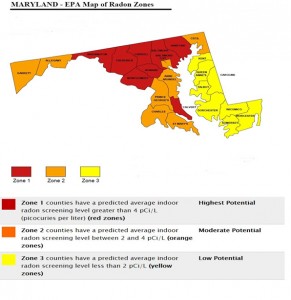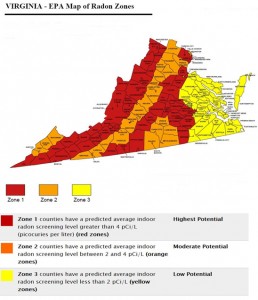Take a look at the RADON levels in your county!
Maryland-EPA map of Radon Zones
- Lifetime warranty on all piping and non-electrical hardware
- 5 Year fan warranty
- Online discounts
- 100% RADON reduction success
- All ADE Radon Mitigation Service Technicians are licensed and insured
- We use supplies 90% made in the United States
Would I need to test my radon level if my house only two years old?
In many instances newly build houses have higher concentration of radon than older dwellings. The geology of the soil where house is built plays an important role in determining the concentration level of Radon gas. Radon is a gas that moves through the ground towards lowest resistance. If you have two houses side by side, one might have high concentration of radon and the other might not. The house that has higher concentration of radon might have cracks in foundation, sump pump gaps where radon can easily escape into the basement. Based on Environmental Protection Agency research 1 in every 15 households in the United States has higher concentration of radon, that is equal or more than 4 pC/Liter.
What is average concentration of radon in US home?
The average concentration of radon in the United States home is 1.3 pC/L.
What is average concentration of radon outside?
Answer: 0.4 pC/L
What is average level of radon where EPA strongly recommends mitigation?
Answer: Equal or higher than 4 pC/L.
In what season of the year the level of radon is elevated?
Answer: Winter, because the difference of temperatures inside vs. outside is higher in winter vs. summer season.
What is average concentration of radon in US home?
The average concentration of radon in the United States home is 1.3 pC/L
What is average concentration of radon outside?
Answer: 0.4 pC/L
What is average level of radon where EPA strongly recommends mitigation?
Answer: Equal or higher than 4 pC/L
In what season of the year the level of radon is elevated?
Answer: Winter, because the difference of temperatures inside vs. outside is higher in winter vs. summer season.
Radon Myths
MYTH: Scientists aren’t sure radon really is a problem.
FACT: Although some scientists dispute the precise number of deaths due to radon, all the major health organizations (like the Centers for Disease Control and Prevention, the American Lung Association and the American Medical Association) agree with estimates that radon causes thousands of preventable lung cancer deaths every year. This is especially true among smokers, since the risk to smokers is much greater than to non-smokers.
MYTH: Radon testing is difficult, time consuming and expensive.
FACT: Radon testing is easy. You can test your home yourself or hire a qualified radon test company. Either approach takes only a small amount of time and effort.
MYTH: Homes with radon problems can’t be fixed.
FACT: There are simple solutions to radon problems in homes. Hundreds of thousands of homeowners have already fixed radon problems in their homes. Most homes can be fixed for about the same cost as other common home repairs.
MYTH: Radon affects only certain kinds of homes.
FACT: House construction can affect radon levels. However, radon can be a problem in homes of all types: old homes, new homes, drafty homes, insulated homes, homes with basements, homes without basements. Local geology, construction materials, and how the home was built are among the factors that can affect radon levels in homes.
MYTH: Radon is only a problem in certain parts of the country.
FACT: High radon levels have been found in every state. Radon problems do vary from area to area, but the only way to know your radon level is to test.
MYTH: A neighbor’s test result is a good indication of whether your home has a problem.
FACT: It’s not. Radon levels can vary greatly from home to home. The only way to know if your home has a radon problem is to test it.
MYTH: It’s difficult to sell homes where radon problems have been discovered.
FACT: Where radon problems have been fixed, home sales have not been blocked or frustrated. The added protection is sometimes a good selling point.
MYTH: I’ve lived in my home for so long, it doesn’t make sense to take action now.
FACT: You will reduce your risk of lung cancer when you reduce radon levels, even if you’ve lived with a radon problem for a long time.
MYTH: Short-term tests can’t be used for making a decision about whether to fix your home.
FACT: A short-term test, followed by a second short-term test* can be used to decide whether to fix your home. However, the closer the average of your two short-term tests is to 4 pCi/L, the less certain you can be about whether your year-round average is above or below that level. Keep in mind that radon levels below 4 pCi/L still pose some risk. Radon levels can be reduced in most homes to 2 pCi/L or below.
- Radon is estimated to cause about 21,000 lung cancer deaths per year, according to EPA’s
2003 Assessment of Risk from Radon in Homes (EPA 402-R-03-003). The number of deaths from other causes are taken from the Centers for Disease Control and Prevention’s 2005-2006 National Center for Injury Prevention and Control Report and 2006 National Safety Council Reports.
Why is it dangerous?
There are few methods we use to permanently reduce the level of radon in your house.
These methods are part of Active Soil Depressurization, also known as ASD
ASD reduces radon entry by mechanically creating suction beneath the foundation, which is stronger than the vacuum applied to the soil by the building.
The most common ones are
Sub-Slab Depressurization (SSD)
SSD is the most common and efficient method of radon mitigation systems. The purpose of sub – slab depressurization method is to lower air pressure under concrete floor slab relative to the indoor pressure. We would use one or more fans based on the scope of the project to have radon removed from underneath of the slab. In addition, we will seal floor and wall cracks. If you have sump pump we will seal sump pit with a removable cover. This process will remove radon gas out and away from your property and release it into outdoor air above the property.
A hole is drilled into your basement or floor slab and 4” PVC pipe is inserted and sealed to the floor. The pipe is routed to the attic or outside where a radon vent fan is connected and vented above the roof.
Sub-Membrane Depressurizaton (SMD) sub membrane depressurization systems are installed at buildings with earthen or gravel crawl spaces or floors instead of slab. With this system, and impermeable membrane (such as plastic sheeting) is placed over the earthen or gravel area and the ventilation piping is installed through the membrane.
We Accept
Contact Us
Membership



NRPP ID # 107458 RMT








